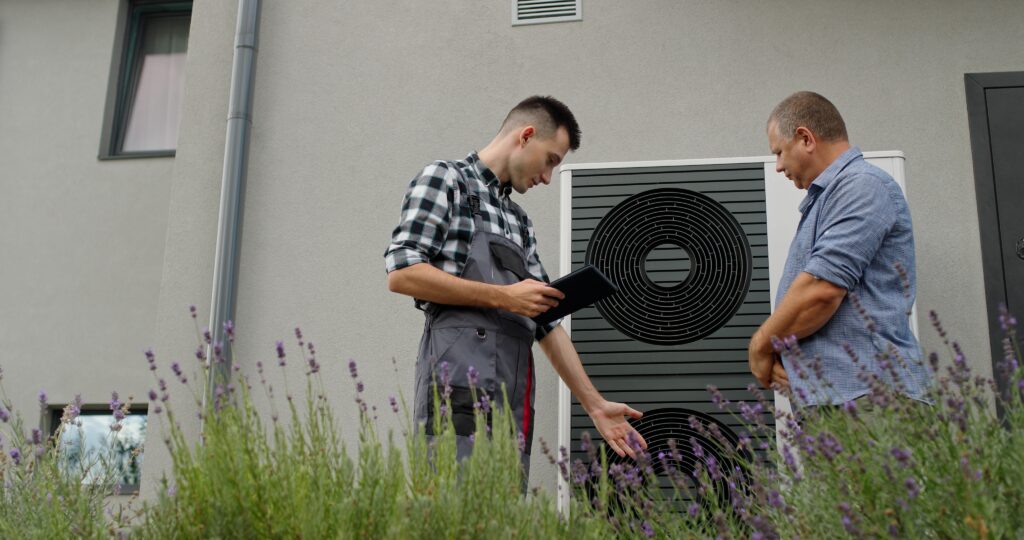How to Prep Your HVAC System for Warmer Weather

Warmer weather is right around the corner, and that means it’s time to get your HVAC system ready to keep you cool and comfortable. Just like spring cleaning your home, giving your HVAC some attention before the temperatures rise can make a big difference.
Prepping your system now means better efficiency, lower energy bills, and no unexpected breakdowns when you need it most.
Plus, simple maintenance makes a huge difference in keeping your home comfortable. Let’s dive into some simple steps to get your HVAC system summer-ready!
Table of Contents
Why Prepping Your HVAC System Matters
Getting your HVAC system ready for warmer weather might feel like just another chore on your to-do list, but it’s worth the effort. It helps extend the lifespan of your unit, saving you money on costly repairs or a full replacement down the road.
Think of it this way: Your HVAC system works hard to keep your home comfortable, but if it’s not properly maintained, it has to work even harder. Over time, neglecting routine maintenance can cause parts to break down, reduce efficiency, and even lead to a complete system failure.
By taking some simple steps to prep your system before things heat up, you can avoid issues like clogged filters, reduced airflow, refrigerant leaks, or even a broken compressor. Not only does this keep your home cooler and more comfortable, but it also helps keep those energy bills in check.
Step-by-Step Guide to Prepping Your HVAC System
Getting your HVAC system ready for warmer weather doesn’t have to be complicated. With a few simple steps, you can help your system run more efficiently and avoid any nasty surprises when the heat kicks in.
1. Inspect and Replace Air Filters
One of the easiest and most important things you can do for your HVAC system is to check and replace the air filters.
Clean filters mean better air quality, improved airflow, and a system that doesn’t have to work overtime just to keep you cool. Plus, dirty filters can make your HVAC unit less efficient, which can drive up your energy bills.
How to Do It:
- First, locate your HVAC air filter. It’s usually found behind a vent grille or in the return air duct.
- Remove the filter and inspect it. If it looks dirty or clogged, it’s definitely time for a change.
- Pop in a new, clean filter that matches your system’s size and specifications.
- Aim to replace the filter every 1-3 months, especially during peak cooling seasons.
2. Clean Vents and Ducts
Over time, dust, dirt, and even pet hair can build up in your vents and ducts, restricting airflow and lowering indoor air quality. Cleaning them out not only helps your system work better but also keeps allergens at bay.
DIY Tips:
- Use a vacuum with a hose attachment to clean around the vents and grilles.
- Wipe down the vent covers with a damp cloth to remove dust.
- If you notice a lot of buildup or think your ducts might need a deeper clean, it might be worth hiring a professional duct cleaning service.
3. Check the Thermostat Settings
When the weather starts to warm up, it’s time to switch your thermostat from heating to cooling mode.
Pro Tip:
- If your thermostat is a bit outdated, consider upgrading to a programmable or smart thermostat. These can automatically adjust temperatures based on your schedule, helping you save on energy costs. Plus, they’re super convenient to control from your phone.
- Make sure the thermostat is set to a comfortable temperature and is working correctly. You don’t want to find out it’s glitchy on the first hot day!
4. Inspect the Outdoor Unit
Your outdoor unit is exposed to all kinds of weather, so it’s no surprise that debris can accumulate around it. Clearing away leaves, twigs, and dirt will help keep the airflow unobstructed and prevent overheating.
What to Look For:
- Clear any debris from around the unit. A good rule of thumb is to keep at least two feet of clear space around it.
- Check the coils and fan blades for visible damage. Bent or broken blades can mess with airflow and efficiency.
- If you notice anything that looks damaged or worn out, it’s best to call a professional for a closer inspection.
5. Test Your System Early
Don’t wait until the first scorching day to find out your AC isn’t working properly. Running your system for a short period before it gets too hot helps you spot potential issues in advance.
What to Do:
- Turn your system on and let it run for about 10-15 minutes.
- Listen for any unusual noises like rattling, banging, or hissing.
- Check if the air coming out is cool and consistent. If it feels weak or warm, that’s a red flag.
- Address any problems now while you still have time to fix them before summer kicks in.
6. Schedule a Professional Maintenance Check
Even if you’re handy with DIY maintenance, it’s always a good idea to have a professional take a look before the hot weather hits. They can spot issues that aren’t obvious and perform essential tasks like checking refrigerant levels, inspecting electrical components, and giving the system a thorough tune-up.
Why It’s Important:
- Professionals have the tools and knowledge to catch small issues before they turn into big (and expensive) problems.
- They’ll check for refrigerant leaks, ensure electrical connections are secure, and make sure the system is running at peak efficiency.
- Scheduling a checkup now means fewer chances of an unexpected breakdown when you need your AC the most.
Taking these simple steps to prep your HVAC system will keep you cool, comfortable, and stress-free all season long. Plus, you’ll save money on energy bills and reduce the risk of sudden breakdowns.
Tips for Keeping Your Home Cool
There are plenty of other simple tricks to help keep your home cool without making your AC work overtime. Here are a few extra tips to maximize comfort and efficiency:
1. Use Ceiling Fans to Reduce HVAC Load
Ceiling fans are a game-changer when it comes to staying cool. They don’t actually lower the temperature, but they create a breeze that makes you feel cooler. This means you can set your thermostat a few degrees higher without sacrificing comfort.
Pro Tip:
- Make sure your fan blades are rotating counterclockwise during the summer. This pushes cool air downward, creating a wind-chill effect that makes the room feel cooler.
- Turn off fans when you leave the room.
2. Keep Blinds Closed During Peak Sunlight Hours
Natural sunlight streaming through your windows can make your home feel like a greenhouse. To keep things cool, close your blinds or curtains during the hottest parts of the day—usually from late morning to early evening.
Simple Fixes:
- Invest in blackout curtains or thermal blinds to block out the heat.
- If you still want some natural light, consider sheer curtains that diffuse sunlight without letting in too much heat.
- Reflective or solar window films are also a great option to reduce heat gain.
3. Utilize Natural Ventilation When Possible
Take advantage of cooler mornings and evenings by opening windows and letting fresh air flow through your home.
How to Make the Most of It:
- Open windows and doors on opposite sides of your home to encourage airflow.
- Use box fans or window fans to help push hot air out and pull cool air in.
- Once the outdoor temperature rises, close everything up and switch back to your AC to maintain a comfortable indoor environment.
Troubleshooting Common Problems After Maintenance
Sometimes, even after you’ve gone through all the steps to prep your HVAC system, things still don’t work quite right. It can be pretty frustrating, but don’t worry—some issues have simple fixes, while others just mean it’s time to call in the pros.
Here are a couple of common problems you might encounter and what to do about them.
1. HVAC Not Cooling Properly
You’ve cleaned the filters, checked the thermostat, and cleared out debris from the outdoor unit, but your HVAC system still isn’t cooling like it should. There are a few common reasons this might be happening.
Potential Causes and Fixes:
- Dirty or Clogged Air Filters: Even if you recently changed the filter, double-check to make sure it’s installed correctly and isn’t clogged with dust.
- Blocked Vents or Ducts: Make sure nothing is obstructing airflow—like furniture pushed up against vents.
- Low Refrigerant Levels: If your system is blowing warm air, it could be a refrigerant issue. Unfortunately, this isn’t a DIY fix. You’ll need an HVAC technician to check for leaks and recharge the system.
- Thermostat Issues: Sometimes, it’s as simple as a thermostat not being set correctly. Make sure it’s on “cool” and not “fan only” or “heat.”
- Frozen Evaporator Coils: If the coils freeze up, your system can’t cool properly. You might notice frost on the outdoor unit or reduced airflow. Turn off the system and let it thaw, but call a technician if the problem keeps happening.
If none of these fixes seem to help, it’s probably best to call an HVAC professional. They’ll be able to diagnose more complex issues that you might not be able to spot on your own.
2. System Making Strange Noises
Your HVAC system usually hums along without much fuss, so when it suddenly starts making weird noises, it’s definitely concerning. Different sounds can point to different problems, so listen carefully to figure out what’s going on.
Common Noises and What They Mean:
- Banging or Clanging: This could indicate a loose or broken part inside the blower or motor. It’s best to shut off the system and call a technician to avoid further damage.
- Squealing or Screeching: A high-pitched squeal usually points to a worn-out belt or motor issue. Again, this is something you’ll want a pro to look at.
- Rattling: Sometimes debris gets stuck in the blower fan or outdoor unit, but it could also mean that parts are coming loose. Try turning off the unit, checking for loose screws, or clearing away debris.
- Hissing or Bubbling: This could mean a refrigerant leak, especially if you notice the air isn’t as cool as it should be. This definitely requires professional attention.
- Clicking: A clicking noise when starting up is normal, but constant clicking could mean an electrical issue. Don’t ignore it, as it might indicate a failing capacitor or relay.
When it comes to strange sounds, the rule of thumb is pretty simple—if it doesn’t sound right, it probably isn’t. Turning off the system and calling an HVAC technician is the safest bet to avoid causing more damage.
Final Thoughts
Getting your HVAC system ready before the warmer weather hits is one of the smartest moves you can make. A little bit of prep now means fewer headaches (and fewer emergency repair calls) when the temperature starts to climb. Plus, you’ll enjoy better efficiency, lower energy bills, and a cool, comfortable home.
By staying proactive with maintenance—like replacing filters, checking the thermostat, and giving your system a quick test run—you’ll be setting yourself up for a stress-free season. And if something doesn’t seem quite right, don’t hesitate to call in a pro.
Additional HVAC Resources

Anna has over six years of experience in the home services and journalism industries and serves as the Content Manager at MyHomePros.com, specializing in making complex home improvement topics like HVAC, roofing, and plumbing accessible to all. With a bachelor’s degree in journalism from Auburn University, she excels in crafting localized, comprehensive guides that cater to homeowners’ unique needs. Living on both coasts of the United States has equipped her with a distinctive perspective, fueling her passion for turning any house into a cherished home through informed, personalized decision-making.








